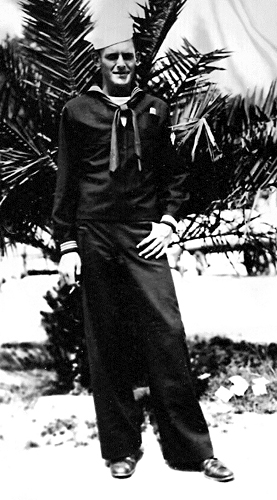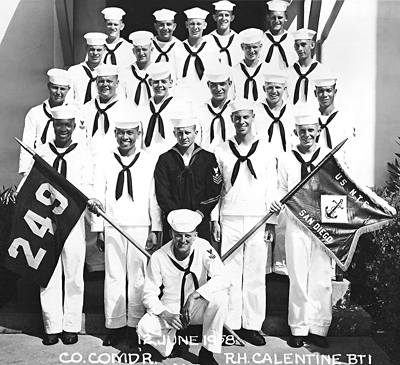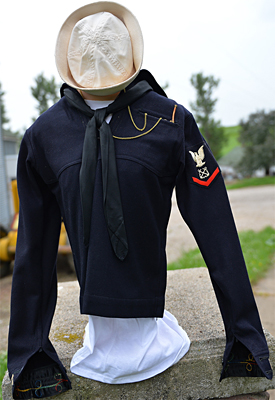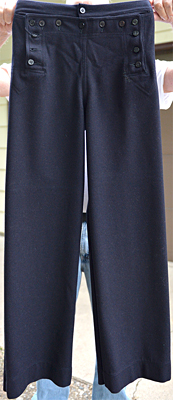

Larry took his basic training at US Naval Training Center, San Diego, California and attended Class "A" Guided Missile School at Dam Neck, Virginia Beach, Virginia.
He served 2 years, 10 months, and 23 days aboard the USS GYATT DDG 1; homeport at that time was Norfolk, Virginia: USS (United States Ship) - (DD stands for destroyer, G for Guided Missile, 1 the first ship of that type).

It was May14, 1959, when Larry went aboard as a crew member in the 1st division (deck crew) for the entire time he was aboard. His duties were cleaning, mess cooking, standing watch, and painting. Cleaning involved interior and exterior (sweeping, mopping, dusting and polishing brass). Mess cooking was keeping the mess deck (serving, eating, and scullery areas clean) and scrapping trays to remove uneaten food and then placed in the automatic dish washer; he also worked on the serving line.
Standing watch involved (at sea) being one of the lookouts on the bridge, being the helmsman (steering the ship) or operating the engine order telegraph (used to communicate with the engine room to tell them how fast we were supposed to go). There were also two officers on the bridge, a BM (boatswains mate - normally pronounced "bosuns mate") of the watch, and a QM (quartermaster) of the watch to keep the record of everything that occurred during the watch, and a JV talker.
All watches were for 4 hours except the morning watch which were two 2-hour watches from 4-6 AM and 6-8 AM so that all the crew could have breakfast.
There was also the Sea Control Watch which was on duty when the ship went alongside another ship to refuel, take on supplies, to highline someone and going in and out of port. Larry's memory: "I remember one time we were refueling from a carrier somewhere in the Atlantic Ocean, I think it was the USS Forrestal CVA 59 aircraft carrier when a wave pushed the Gyatt in close to the Forrestal (less than 50 feet between us) and it got pretty exciting on the bridge, I was on the wheel at the time, the captain had been out on the starboard side and looked up and saw the flight deck over top of us (Forestall was on the port side) and came running in and asked where my rudder was (it was at 30 degrees right rudder - NOT a place you would normally have your rudder while alongside another ship). I was trying to get us back out away from the carrier (we were about half done with the refueling) when the captain said break the rig, the 1MC talker barely got that out of his mouth when the captain said all ahead full, right 15 degrees rudder. Forestal didn't even have time to stop pumping so we both got black oil down our sides. Did not make the side cleaners happy on either ship but at least we didn't hit them. I had a short talk with the captain in his sea cabin when I got off watch. He told me to not let that happen again!!!"
A second memory by Larry: "Another "little" foul up was once when we were taking the ship up the Cooper River near Charleston, South Carolina, to offload ammo, I was on the wheel as usual for those operations. Apparently the conning officer gave the wrong rudder command or I misunderstood him and all at once it got exciting on the bridge again. We were heading for a pier and that is not a good thing. The next thing I heard was HARD RIGHT RUDDER (which means put the rudder into the mechanical stops) then came STARBOARD ENGINE BACK FULL, PORT ENGINE AHEAD FULL. Normally it takes a few minutes for commands like that to take effect but that day everybody must have been holding their mouth right. You can feel the ship give a shudder when you reverse an engine when you are underway and it happened immediately or so it seemed. I was watching through the front windows of the bridge and it looked like we were going to split the pier right down the middle.
Slowly the point of the bow began to move towards the right as we were kind of turning in our own length which you CAN NOT do with a destroyer under way BUT it worked and we didn't even touch the pier and were on our way back into the channel.
I had a visit with the XO (Executive Officer) in his cabin over that one and got more good advice to NOT do that again."
In 1961 Larry took the service-wide test on the Gyatt. The results were sent to naval headquarters for grading and those with the highest scores were promoted; of which Larry was one, so he was promoted to BM3 from 1st division. Larry remembers the results were posted while they were in Livorno, Italy.

Larry was stationed at two ports, Norfolk, Virginia, and Charleston, South Carolina. While on the Gyatt they made about 70 ports of call at various locations with 2 Atlantic crossings; the Caribbean, eastern seaboard of the United States, Puerto Rico, and the Mediterranean (during the trip over to the Mediterranean the crew had a mustache growing contest and Larry won 2nd prize).
Larry was discharged from the Navy on April 6, 1962.
On July 12, 1965, Larry enlisted in the US Army and served through July 11, 1968. He took basic training at Ft. Leonard Wood, Missouri. After basic, he attended Teletype Equipment Repair School at Ft. Gordon, Georgia, where he was honor graduate and had the highest scores ever recorded to that time in the school. After completing his schooling, Larry was assigned to the USAAMAC (United States Army Aviation Maintenance Center) at Coleman Barracks, Sandhofen (near Mannheim), Germany. They left the US mainland on a on a troop ship and arrived at Bremerhaven, Germany, around April 12, 1966. From there they took the train to Mannheim and a bus to Coleman Barracks, where Larry spent the rest of his enlistment working in Avionics (aviation electronics), mainly for helicopters.
Larry's memory: "One time at Coleman Barracks, I remember one pilot that brought in a chopper from England who told me he was having problems with everything. That could only mean one thing, the motor box control was bad, I loosened the screws that held the top of it in and looked inside, the main cable (about 25 wires coming out of the box were all broken about 2 inches from the connector (he had flown it the entire way by the seat of his pants) I told him it would take a couple of days to get the harness replaced and he went ballistic. He said he had to get back to England by the next morning and other choice words. I took him to my officer in charge and told the OIC what was wrong with the chopper. The OIC asked me to wait outside. After I left the room, the two of them talked for about 5 minutes then I was called back in. The OIC asked if I could splice the cable, I said sure but that it wasn't SOP (Standard Operating Procedure); the OIC said he knew I could do it. After I said yes, the OIC said that the pilot was accepting responsibility for the splice and I would not be held responsible for it. I asked - in writing with your OK on it and he said yes. So I spliced all the wires and added about three inches of new wire to each one to allow for flexing. I guess the pilot made it back to England, never heard of a chopper crashing around that time. Occasionally a spy plane '"Mohawk"' would come in and need repair."
The next assignment for Larry was in 1967, while on TDY (Temporary Duty) at Laon, France. Laon is located about 105 miles northeast of Paris. They were stationed in Laon to tear down a Butler building (80x240 feet) and get it ready for shipment back to USAAMAC. The building was actually made up of four 60x80 foot buildings that had been built side by side with no interior walls so there were four peaks to the roof line. It was located on an Air Force base that had been closed so they had to stay at the hotel/cafe/bar in town while they were there. They were in Laon from February 17 to March 14, 1967.
On their last weekend before leaving Laon, five of them made an excursion to Paris (just to be able to say, "been there - done that"). They arrived in Paris about an hour before sunset and drove around for a couple of hours where they saw the Arc de Triomphe, the Eiffel Tower, and a lot of crazy drivers (they were unanimous in that opinion) while driving around. Next they went to "Pig Alley" (Rue du Pont Pigy) where the driver parked his car. Pig Alley has no resemblance to what Americans would call an alley, it was one of the widest streets that Larry had ever walked on, the other was the Ramblas in Barcelona, Spain, where he had been July 13-18, 1960, and again December 4-11, 1961, (while Larry was in the Navy).
While wandering around Pig Alley, they stopped at a bar (read strip joint) for a beer. The five of them each ordered a beer and when the waiter returned with them, he said "20 Francs." They didn't think that was too bad (for the same beer they were drinking at their hotel in Laon was 15 cents (at that time, 20F was equal to $4.00). The problem was that after one of the guys gave the waiter 20F, he just stood there waiting, the price was actually 20F each! They all sat there and sipped their beers and watched the entire floor show while the waiter kept trying to get them to buy another round; he didn't appreciate their lowly business.
After leaving that bar they walked around and found another bar on one of the side streets where they could get a beer for 2F; more in their price range. The guys returned to Laon about 4 in the morning.
RETURN TO USAAMAC When they had completed their work in France and it was time to go back to Germany, the driver asked if they wanted to take the short or long way back - they chose the long way which was through Belgium and Luxembourg (another been there - done that).
They took the road north to Brussels, Belgium, and from there they turned southeast to go to Luxembourg (country and city). They saw many old buildings (built circa 1000-1400 AD) and it was surprising to them how many remained standing after all of the wars that were fought in the area.
Larry was discharged from the Army while at Coleman Barracks, in Germany on July 11, 1968, and lived as a civilian in Mannheim until September 28, 1969, before returning to the US.
After returning to the US Larry worked for Farmers Hybrid in Perry, for 3 years, and was then transferred to Moville, Iowa, for two years, where he was in charge of the seed warehouse and had various duties such as hiring and delivery of seed during the winter and spring and overseeing the summer detasseling. After that Larry spent 3 years at Central Harvestore in Adel, Iowa. Later he went to DMACC in Ankeny for a Basic Telephone Equipment course and worked during summer break at Heart of Iowa Telephone Co-op. in Union, Iowa. Next he worked for Foster Design Co. in Wichita, Kansas, and given the position as an Outside Plant Telephone Engineer for three years at South Western Bell Ponca City, Oklahoma. He came back to Iowa where he worked at ISU for 15 years and then retired.


Private funeral services will be held with burial at the Iowa Veterans Cemetery in Van Meter, Iowa. Funeral arrangements are entrusted to the Dahn and Woodhouse Funeral Home in Glidden and online condolences may be left for the family at www.dahnandwoodhouse.com
Larry was born on May 16, 1938, in Manning, Iowa, the son of Harold Herman and Lucille Vivian Marie (Hagedorn) Hodne. Larry grew up in Manning where he graduated from high school in 1956. He enlisted in the United States Navy following high school and served six years mostly on the USS Gyatt. Upon his honorable discharge, Larry reenlisted in the United States Army and served four more years. Following his military service, Larry lived in Perry and most recently he lived in Glidden. He enjoyed gardening and he was very passionate about genealogy.
Larry is survived by three children: Denton Hodne of Texas, Shawn Bennett (Dax), and Melissa Hodne of Carroll; eight grandchildren: Shane, Tyler, Trenton, Anna, Jimmy, Ashleigh, Andrew and Savannah; a great-granddaughter Honor; his brother Randy Hodne of Perry; and other extended family members and many good friends. Larry was preceded in death by his parents Harold and Lucille Hodne.